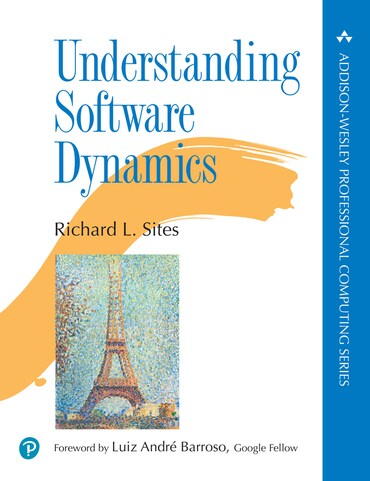
Title overview
World-renowned software performance expert Richard Sites offers expert methods and advanced tools for understanding complex time-constrained software dynamics, improving software reliability, and troubleshooting challenging performance problems. He addresses CPU, memory, disk, network, and more, helping students fix programs that are always too slow, or work well at times but inexplicably slow down at other times.
Sites draws on several decades of experience pioneering software performance optimization, and extensive experience teaching developers at the graduate level. He introduces principles and techniques which can be used in any environment, from embedded devices to datacenters, illuminating them with examples based on x86 or ARM processors running Linux and linked by Ethernet. Sites also guides students through building and applying a powerful new extremely-low-overhead open source software tool, KUtrace, to trace exactly what is executing on every CPU core. Using insights gleaned from this tool, students can apply nuanced approaches to performance enhancement—not merely brute-force techniques such as turning off caches or cores."In the Preface, Sites mentions that he got many helpful suggestions while teaching graduate-level courses after retiring from Google… I think that any senior CS student … can benefit by reading this book. While all the material in the first half of the book leads up to the use of KUTrace, the first two parts are worth reading on their own by anyone who wants to better understand the systems they are building and using."—Rick Farrow, ;login
- Master approaches which can be applied anywhere from mobile apps to datacenters and the cloud
- Find and resolve the root causes of delays and other performance anomalies
- Gain deep practical experience by building and using an extremely-low-overhead tool for tracing what is executing on every CPU core
- By Richard Sites, a pioneer in performance monitoring at Google, Adobe, HP, IBM, DEC, and beyond
Table of contents
Preface xxi
Acknowledgments xxv
About the Author xxvii
Part I: Measurement 1
Chapter 1: My Program Is Too Slow 3
Chapter 2: Measuring CPUs 15
Chapter 3: Measuring Memory 31
Chapter 4: CPU and Memory Interaction 49
Chapter 5: Measuring Disk/SSD 61
Chapter 6: Measuring Networks 85
Chapter 7: Disk and Network Database Interaction 111
Part II: Observation 131
Chapter 8: Logging 133
Chapter 9: Aggregate Measures 141
Chapter 10: Dashboards 157
Chapter 11: Other Existing Tools 167
Chapter 12: Traces 193
Chapter 13: Observation Tool Design Principles 209
Part III: Kernel-User Trace 217
Chapter 14: KUtrace: Goals, Design, Implementation 219
Chapter 15: KUtrace: Linux Kernel Patches 227
Chapter 16: KUtrace: Linux Loadable Module 239
Chapter 17: KUtrace: User-Mode Runtime Control 245
Chapter 18: KUtrace: Postprocessing 249
Chapter 19: KUtrace: Display of Software Dynamics 257
Part IV: Reasoning 267
Chapter 20: What to Look For 269
Chapter 21: Executing Too Much 271
Chapter 22: Executing Slowly 279
Chapter 23: Waiting for CPU 289
Chapter 24: Waiting for Memory 299
Chapter 25: Waiting for Disk 307
Chapter 26: Waiting for Network 319
Chapter 27: Waiting for Locks 337
Chapter 28: Waiting for Time 357
Chapter 29: Waiting for Queues 361
Chapter 30: Recap 383
Appendix A: Sample Servers 387
Appendix B: Trace Entries 391
Glossary 397
References 405
Index 415